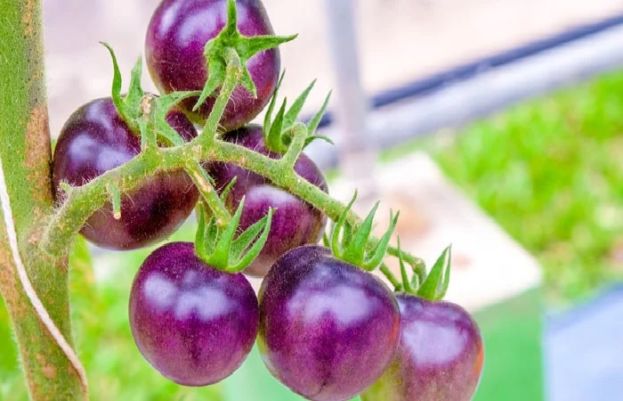A cutting-edge tomato cultivar known as purple tomato has gained prominence in the world of genetically modified produce, grabbing the interest of home gardeners and foodies everywhere. With its distinctive form, taste, and possible health advantages, the purple tomato is upending our preconceived notions about the humble fruit. In the field of genetically modified food crops, Norfolk Plant Sciences’ purple tomatoes are trailblazers. It’s the first crop of its kind to be sold directly to backyard gardeners. The inclusion of colour genes from a snapdragon flower is responsible for the concord grape-like colour and plum-coloured flesh of this unusual species. The tomato’s anthocyanin levels are raised by this genetic change, which may improve the fruit’s nutritional value, according to BNN. The purple tomatoes are categorised as an indeterminate large-fruited cherry tomato with a savoury, earthy flavour. They have very strong vegetative growth and a sturdy main stem that can grow up to 12 to 15 feet in height. When a fruit is ready to be harvested, its flesh and skin change purple and turn green. This cultivar takes about 70 days to mature providing a rewarding harvest for patient gardeners. Beyond nutrition and appearance, purple tomatoes may have other advantages. To track the freshness of prawns, researchers Qi and Li created colourimetric films with anthocyanins taken out of purple tomatoes. The inventive use of natural hues in this product illustrates how genetically engineered food can improve food safety. The study describes how the researchers used anthocyanins as a colourimetric indicator and polyvinyl alcohol as a film-forming substance. It was published in the journal Polymers in 2024. The films change from purple to green to indicate the presence of amines generated by rotten prawns. This change in colour acts as a visual message to customers about how fresh the prawns are. The purple tomatoes are an example of human inventiveness and nature’s adaptation as we continue to investigate the potential of genetically engineered crops. These distinctive kinds add to our understanding of food safety and sustainability while also providing different flavours and possible health benefits. It serves as a reminder that the common tomato still has stories to tell and lessons to impart in a world where the demands placed on our food systems are growing. Beyond simply being a vegetable, the purple tomatoes are a sign of a future in which nature and technology coexist peacefully to support both our physical and mental needs.
Rich in anthocyanins — Are purple tomatoes better than red ones for health?

